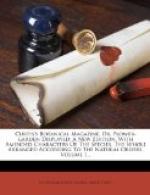LIMONIUM Rauwolfii Marsh Buglosse. Parkins. Parad. p. 250.
[Illustration: 71]
That this singular species of Statice was long since an inhabitant of our gardens, appears from PARKINSON, who in his Garden of Pleasant Flowers, gives an accurate description of it, accompanied with an expressive figure; since his time it appears to have been confined to few gardens: the nurserymen have lately considered it as a newly-introduced species, and sold it accordingly.
It is one of those few plants whose calyx is of a more beautiful colour than the corolla (and which it does not lose in drying); it therefore affords an excellent example of the calyx coloratus, as also of scariosus, it being sonorous to the touch.
Being a native of Sicily, Palestine, and Africa, it is of course liable to be killed with us in severe seasons, the common practice is therefore to treat it as a green-house plant, and indeed it appears to the greatest advantage in a pot; it is much disposed to throw up new flowering stems; hence, by having several pots of it, some plants will be in blossom throughout the summer; the dried flowers are a pretty ornament for the mantle-piece in winter.
Though a kind of biennial, it is often increased by parting its roots, but more advantageously by seed; the latter, however, are but sparingly produced with us, probably for the want, as PARKINSON expresses it, “of sufficient heate of the Sunne.”
[72]
Helleborus lividus. Livid or Purple Hellebore.
Class and Order.
Polyandria Polygynia.
Generic Character.
Cal. nullus. Petala-5. sive plura. Nectaria bilabiata, tubulata. Caps. polyspermae, erectiusculae.
Specific Character.
HELLEBORUS lividus caule multifloro folioso,
foliis ternatis. Ait.
Hort. Kew. ined. 2. p. 272.
[Illustration: 72]
It is not a little extraordinary that this plant which has for many years been cultivated in this country, should have escaped the notice of LINNAEUS; it is equally wonderful that we should at this moment be strangers to its place of growth.
Having three leaves growing together, it has been considered by many as the trifoliatus of LINNAEUS but his trifoliatus is a very different plant, a native of Canada, producing small yellow flowers.
It has been usual to treat this species as a green-house plant, or at least to shelter it under a frame in the winter; probably it is more hardy than we imagine.
It is propagated by parting its roots in autumn, and by seeds, though few of the latter in general ripen, nor do the roots make much increase—to these causes we must doubtless attribute its present comparative scarcity.
It flowers as early as February; on which account, as well as that of its singularity, it is a very desirable plant in collections.




